Part 2: How infrastructure assets are currently managed
2.1
In this Part, we set out what we have learned about how local authorities currently manage their infrastructure assets. This Part draws together information from our analysis of:
- all local authorities' audited financial statements and long-term plans (see paragraph 1.5); and
- asset management information for 31 local authorities (see paragraph 1.6).
Approaches to financial strategy
2.2
In our 2012 report, Matters arising from the 2012-22 local authority long-term plans, we set out the themes that we repeatedly observed in long-term plan financial strategies. These themes were:
- reducing or deferring spending;
- an increased use of district-wide funding to spread the costs of upgrading infrastructure for small communities;
- the need for several large infrastructure projects to meet legislative requirements;
- a focus on stabilising or reducing overall debt; and
- delaying capital projects because of lower or uncertain growth.2
2.3
Local authorities adopted financial strategies that included "just-in-time" responses to growth-related capital expenditure. Many reduced the forecast level of renewals and took a "sweating the assets" approach – which meant delaying renewals work until it was unavoidable. Local authorities were also reducing the "nice to have" projects and adopting "run to failure" approaches – which meant waiting until a component stopped working before replacing it, rather than replacing a component before it failed.
2.4
Local authorities took these approaches to rein in rate increases and to maximise their efficiency. However, such approaches might not be appropriate in some circumstances. Research has shown that optimisation analysis can result in between 15% and 25% long-term cost savings compared to reactive maintenance planning.3 Therefore, using such approaches could mean that local authorities miss opportunities for appropriate interventions that could be more effective in the long run.
2.5
Figure 1 sets out what the Institute of Public Works Engineering Australasia New Zealand considers to be common problems with long-term planning by local authorities.
Figure 1
Common problems with long-term planning by local authorities
The Institute of Public Works Engineering Australasia identifies the following long-term planning issues it says are common among local authorities:
Challenges in looking out 30 years and beyond include:
|
Source: Institute of Public Works Engineering Australasia New Zealand, Infrastructure Strategy Discussion Paper, October 2014.
Current approaches make better and integrated information essential
2.6
To carry out effective and integrated infrastructure strategies, local authorities need to:
- have good information about the condition and performance of their assets;
- integrate that information with financial and service delivery decisions and risk management; and
- link their spending on maintenance and renewals to an optimised decision-making approach.
2.7
Decisions about how to manage infrastructure need to be made in the context of each local authority's financial position and prospects, and the circumstances of its community. Local authorities cannot separate decisions about their assets and service delivery from considerations about funding sources and timing (of funding and of renewal or replacement work). Asset intentions need to be matched with revenue and financing policies and funding tools, which, in turn, are based on information about assets and service delivery.
2.8
Decisions about infrastructure investment and services require effective and defined connections between assets, service delivery levels, and funding. Asset management decisions are so closely linked to a local authority's financial strategy that any weak link can undermine the strength of the "asset management chain".
2.9
Figure 2 shows how we see asset management and financial strategy interacting to contribute to good infrastructure strategy.
Figure 2
Aspects of asset management that contribute to good infrastructure strategy
Note: Sections 101A and 101B are references to the Local Government Act 2002.
Approaches to infrastructure strategy
2.10
All local authorities forecast their asset values and capital expenditure for at least 10 years. Some local authorities forecast for a longer period. For example:
- Nelson City Council's plans for managing its three waters assets use 30-year forecasts for capital expenditure and renewals.
- To work out depreciation and likely effects on rates revenue, New Plymouth District Council uses 50-year roading forecasts.
- In 2012, Kapiti Coast District Council prepared a 20-year long-term plan.
- Hastings District Council completes renewal forecasts to 2122. It prepares forecasts to 2062 for water supply capital expenditure and 10-year forecasts for operating expenditure. Its water supply optimisation study includes anticipated growth in keeping with the Council's urban growth strategy for the next 50 years.
Assumptions are mainly about cost factors
2.11
When local authorities forecast their spending, they typically base their forecasts on assumptions about:
- the reliability of the estimated costs of major projects or capital items;
- expected inflation or cost adjustment factors;
- funding uncertainties, such as the level and amount of funding that the New Zealand Transport Agency (NZTA) will provide; and
- consequential effects on operating expenditure of the forecast capital additions.
Capital expenditure trends show local authorities achieve less than planned
2.12
Figure 3 shows the forecasts of capital expenditure from all local authorities' 2006, 2009, and 2012 long-term plans, and annual plan budgeted and actual capital expenditure from 2011 to 2013 annual reports.
Figure 3
Forecast capital expenditure in annual plans and long-term plans, and actual capital expenditure in annual reports
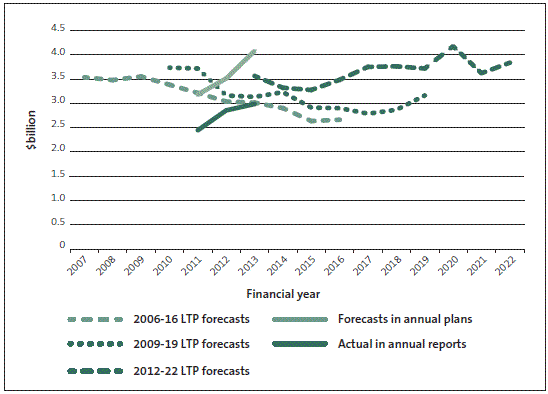
2.13
Figure 3 shows that the actual capital expenditure for 2011 to 2013 recorded in annual reports is quite different from that forecast in earlier annual plans and long-term plans.4 Collectively, local authorities have spent less on capital expenditure than forecast from 2011 to 2013.
2.14
Industry experts and practitioners told us that there are a variety of reasons for the differences between forecast and actual capital expenditure. These reasons include:
- aspirational budgeting and/or poor planning, such as being too optimistic about timing and obtaining the necessary resource consents;
- reprioritising capital expenditure in response to unexpected events;
- delaying growth-related expenditure because of lower than expected or uncertain growth; and
- getting better contract rates than those budgeted for.
2.15
Our analysis suggests that capital planning has considerable variation and uncertainty, which results in a tendency to not spend as much as intended. It suggests that local authorities need to improve how they:
- identify capital expenditure requirements;
- assess the funding tools available to cover the expenditure;
- consider who will do the capital work; and
- match raising funds with carrying out capital work.
2.16
Some local government entities are working to improve their asset and associated capital expenditure management. Figure 4 shows how Auckland Transport is working to manage its capital expenditure.
Figure 4
How Auckland Transport optimises capital management and expenditure
| Auckland Transport is a council-controlled organisation and a subsidiary of Auckland Council. Auckland Transport was formed in November 2010. It is responsible for all the Auckland region's transport services (excluding state highways), from roads to footpaths, cycling lanes, parking, and public transport. Auckland Transport owns $16 billion of assets. These assets include 7200km of roads, 100,000 street signs, 536 signalised intersections, 1585 bus shelters, and 58 railway stations and ferry terminals. Budgeted capital expenditure for 2013/14 is about $859 million, and operating cash expenditure is about $603 million. Auckland Transport has been working on its asset information, decision-making systems, and capital works programming to deliver its capital programme better. |
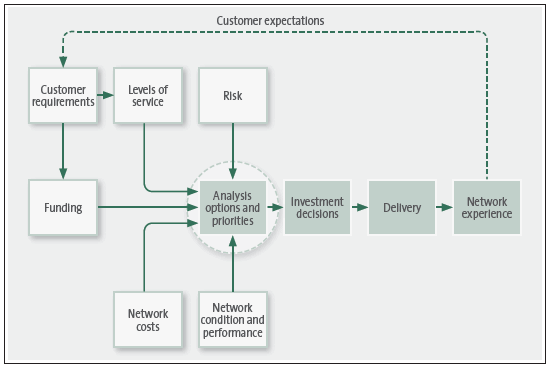
| Auckland Transport has prepared a model for forecasting renewals work based on the condition of its assets. The model has been reviewed by NZTA, the Ministry of Transport, University of Auckland, and others in local government. |

| Auckland Transport's asset management initiatives mean that it has a well-understood programme of both renewals and new capital projects. Its scale of operations means that, if there are delays or issues with one project, another project of a similar priority is ready to be advanced. This means that the capital programme as a whole is not unduly delayed. For 2013/14, Auckland Transport achieved a financial result within 1% of its renewals capital budget. It believes that its forecasting model could be useful to other local authorities. Auckland Transport plans to further refine its forecasting model to reflect the factors that influence customer satisfaction and prioritise renewal work based on both the condition of the assets and customer satisfaction measures. Auckland Transport told us that it is doing further analysis that will allow it to directly compare the cost of renewal and the requirements for maintenance expenditure. |
Source: Auckland Transport.
Asset management information systems used by the 31 local authorities
Most local authorities do not use the full functionality available in their asset management information systems
2.17
For entities with complex networks of assets, a formal asset management information system (AMIS) is an important tool for dealing with the amount of information and analysis needed to support those assets.
2.18
Asset managers and decision-makers need a formal AMIS to help determine whether the best course of action is to maintain, renew, or replace (through new capital investment) assets. An AMIS can transparently justify the level and funding of asset-related spending.
2.19
The basic features of an AMIS provide essential information about assets. These basic features are what local authorities most commonly use. The features include the asset register, financial information, maintenance work recording, condition assessments, a record of which assets are critical, and a record of customer service requests.
2.20
However, few local authorities use the more advanced functions offered by an AMIS. Advanced functions can include maintenance planning, asset performance, deterioration modelling, life-cycle cost optimisation, work management, risk management, and inventory control.
2.21
In our view, using a fuller range of AMIS functionality would help local authorities to manage better quality and more consistent information about their assets. Industry experts agreed that using more AMIS functionality is necessary and that there is no need for this to be difficult.
2.22
Figure 5 shows the range of AMIS functionality from minimum to advanced.
Figure 5
Information Systems Maturity Index
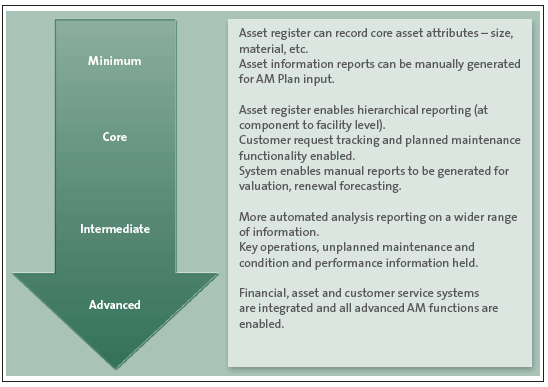
Source: NAMS (2011), International Infrastructure Management Manual, page 4/28.
2.23
As for any important information system, a local authority should carry out formal reviews to ensure that its AMIS is reasonably comprehensive, complete, and cost-effective. An AMIS should meet the needs of its users.
Asset information and financial management information is manually integrated
2.24
The AMIS is often the repository for all detailed information about physical assets. The AMIS needs to be integrated with the financial management information system (FMIS). The 31 local authorities we reviewed all have separate information systems for managing their assets and for managing their finances.
2.25
An FMIS can also include information about financial activities related to assets, such as the fixed asset register. The types of information extracted from the AMIS include additions, renewals, disposals, depreciation charges, revaluations, and useful lives.
2.26
Both the AMIS and FMIS are important for managing a local authority's infrastructure and financial strategy. They need to integrate and be easily reconciled. Manual interfaces that are not reconciled frequently create information management risks.
2.27
Most local authorities periodically import the source data from their AMIS into their FMIS. This process is predominantly manual – that is, there is no automatic interface between the two systems. Most local authorities reconcile, calibrate, and correct the information between the AMIS and FMIS each year when they prepare their financial statements. A smaller number of local authorities reconcile this information in real time or monthly.
2.28
A few local authorities aspire to have one system that incorporates all their asset and financial information. One system will reduce the risk of errors in transferring the information between systems. Using a fuller range of the functionality of an AMIS and FMIS could also reduce the risk of errors and the reliance on manual procedures.
2.29
Most local authorities have a hierarchy and assigned categories of data about their assets. These categories are used to help local authorities with decisions about the criticality of the level of service to be delivered and the condition to be maintained. Most local authorities are confident that their AMIS contains all the important information about their significant and major assets.
Transport funding requirements mean that asset systems and information about roads are reasonably maintained
2.30
NZTA requires local authorities to record specific roading information to receive roading subsidies. All local authorities use the Road Assessment and Maintenance Management (RAMM) software to record information about their roading assets. This means that there are formal expectations and standards of completeness and accuracy for information about roading assets. All local authorities are subject to regular NZTA audits of their roading asset information. Local authorities also carry out their own informal reviews.
2.31
Some types of roading assets (such as retaining walls and road signs) are usually not recorded. In some instances, lower value bridges are also not recorded. Local authorities are progressively adding unrecorded assets to their AMIS when inspections are carried out.
2.32
The 31 local authorities know what information about their assets they need, and all (except one) have a formal asset data hierarchy for their roading assets. Two-thirds were confident that the roading information in their AMIS was reliable enough for their business needs.
Greater variability in use of an asset management information system for three waters assets
2.33
For their three waters assets, all but one of the 31 local authorities use external proprietary software for their AMIS or a mixture of externally and internally developed software. The most common systems include Hansen and AssetFinda. Other local authorities use the Detailed Asset Register, Infonet, Geographic Integration System (GIS), Work-It, and Napier Computer Systems (NCS).
2.34
Only about half of the 31 local authorities carry out some form of regular and formal review of their AMIS. Most carry out informal reviews from time to time. Twelve had not carried out any formal review of the effectiveness of their AMIS.
2.35
In our view, core systems need to be regularly and formally reviewed.
2.36
Usually, underground water components, such as connection pipes, that have not yet been identified are not recorded. Because the mains and end points are known, pipe length can generally be reliably estimated.
2.37
All but one of the 31 local authorities know the information they need about their three waters assets and have formal asset data hierarchies for those assets. One local authority said it does not reconcile its AMIS and FMIS for its three waters assets.
2.38
Some of the local authorities did not have recorded formal expectations or standards for the completeness and accuracy of asset information. They were slightly less confident about the reliability of water asset information in their AMIS (compared to roading assets). Most said that their water asset information met their expectations to deliver the relevant services.
Network performance by the 31 local authorities and the condition of components
Information and condition is better for assets that can be seen
2.39
An asset's performance is measured by its ability to provide the required level of service to customers. Generally, this can be assessed in terms of reliability, availability, capacity, and meeting customer demands and needs. A well-performing asset should also help reduce overall operating costs. Measuring an asset's performance should include all factors that could contribute to the asset failing to provide the required level of service.
2.40
Information about assets depends on local authorities' ability to check and assess those assets. Local authorities need to systematically collect data on the condition of their assets –particularly the most critical assets in a network. Networks of connected assets are only as strong as their weakest link.
2.41
Asset management interventions should be driven by data about the factors that determine the cost of service to ratepayers and other users. This includes information about:
- performance, condition, works, and cost, which is required to understand the current cost of service and trends;
- cost driver information such as demand, volume, input price, and demand-related decay models, which is required to forecast maintenance and renewal need and cost; and
- works achieved compared to target/expectation, maintenance compared to renewals expenditure, unit service delivery costs, and condition, which is required to assess trends in the effectiveness and efficiency of maintenance and renewal programmes.
2.42
Condition and performance information should be used to make good decisions about risk management to avoid asset failures, assess the useful lives of assets, and inform asset management renewal and retirement strategies.
2.43
Condition and performance information also determines the need for, and timing of, preventative or remedial action to prevent any loss of service. If a local authority does not know the current condition (and performance) of an asset, this could lead to premature failure, which would leave the local authority with only one option – to replace the asset. Interdependence in and between systems or networks can mean that the failure of a small part in one network can cascade into a multiple or large network failure.
2.44
Local authorities tailor their approaches to concentrate on critical or significant assets, and they have rating scales for the condition of their assets. The information that local authorities hold about surface assets, including condition information, is generally better than their information about below-ground assets.
Roading assets
2.45
All of the 31 local authorities have formal systems for capturing and recording information about the performance of their roading assets. All local authorities carry out regular and formal assessments of the condition of their roading assets.
2.46
The condition of roading surface assets is generally better than the below-ground basecourse. Bridges also appear to be in poorer condition, especially in rural areas, which could be a consequence of greater traffic volumes and heavier vehicles. If upgrading is not an immediate option or priority, local authorities are increasingly using weight restrictions on such bridges. However, weight restrictions effectively lower the service provided by the transport network.
Three waters assets
2.47
Most local authorities have formal systems for capturing and recording the performance of their three waters assets and carry out regular formal assessments of their condition. However, local authorities are likely to know more about newer assets than about older assets (those that have been in the ground for 50 years or more).
2.48
How old an asset is and renewals expenditure to depreciation appear related. "Newer" storm water assets might not require significant renewals expenditure in the near future compared to water supply assets that are older and require more renewals investment.
Asset condition and performance information needs to improve to support decision-making
2.49
Engineers, operations managers, and asset managers generally receive asset condition information. Depending on the nature of the issues, condition information is also reported to the managers and governing body. However, the trends outlined in this Part suggest that decision-making is not supported by the information reported.
2.50
We see parallels between the overall state and practice of local authorities' asset management information and the findings we reported in our 2011 and 2013 reports on Transpower New Zealand Limited. Figure 6 shows how Transpower responded to our findings.
Figure 6
Transpower New Zealand Limited – moving from extensive data to an integrated approach
| In our 2011 report on Transpower New Zealand Limited, we noted that Transpower's AMIS did not have the capabilities of a modern asset management system. Although Transpower collected an extensive amount of data, it stored the data in a relatively unstructured way, making it difficult to access. Transpower's AMIS also did not allow predictions to be made. In 2013, we followed up on our 2011 report on Transpower. We found that Transpower had made good progress in developing an integrated approach to managing assets, had been proactive in its efforts to improve asset and risk management of the national grid, and was appropriately addressing long-term risks to the grid's performance. Transpower recently received full certification to PAS 55, the British Standards Institution's Publicly Available Specification for Asset Management (which is relevant to gas, electricity, and water utility companies, road and air travel systems, public facilities, processing, and manufacturing and natural resource industries). PAS 55 is an internationally recognised certification for any organisation wishing to demonstrate a high level of professionalism in life-cycle management of their physical assets. |
2.51
Public reporting is often provided through asset management plans, including asset strategic planning, and long-term plans, annual plans, and annual reports (which have some asset information) on a local authority's website. Local authorities have a range of performance measures of service levels in public accountability documents. These have usually been drawn from asset and/or activity management plans. However, we found little relationship between public information about asset service levels and financial trend information.
2.52
Several initiatives emphasise the importance of ongoing monitoring and use of network asset metadata, which relies on capturing quality data and having consistent data definitions. Figures 7 and 8 set out two examples of these initiatives.
Figure 7
Transport Analytics Governance Group – developing a common metadata standard
| The Transport Analytics Governance Group (TAGG) is a consortium of Auckland Transport, Wellington City Council, Christchurch City Council, and NZTA. The partners in the consortium have in common their transport business, high-volume networks, similar frameworks and information systems, and the dynamic nature of their networks. The main project in the initial phase is a review of asset metadata standards. Improved functionality in asset management systems has provided an opportunity to standardise practices for all road-controlling authorities. The potential benefits of adopting a common metadata standard include improved quality of asset records, reduced costs of creating asset data, reduced supplier's costs, lower software development costs, an open digital environment that enables innovation in development, sharing asset analytics between different organisations, and enabling detailed national benchmarking – for a range of infrastructure sectors, both public and private. The metadata standard also meets several international standards. This project's scope includes inventory, works, condition, and performance data, although the initial focus is on inventory. The metadata standard will describe geospatial, image, numerical, and textual asset information. NZTA is appointing a research contractor to advise on the transition process to adopting fully automated road infrastructure condition monitoring, with the objective of improving the quality, consistency, and coverage of condition data. Collectively, the metadata standard and automated condition rating are also required to manage the potential divergence in measurement standards proposed by the many vendors and suppliers of new technology condition-rating devices. |
2.53
Wellington City Council is using geospatial analytics to forecast its infrastructure asset needs beyond 30 years.
Figure 8
Wellington City Council – using geospatial information to forecast infrastructural asset needs
Wellington City Council estimates that its assets are decaying at a rate of $2 million each week. In response, the Council is taking an interdisciplinary evidence-based approach to inform decision-making and long-term planning. Its approach incorporates:
|
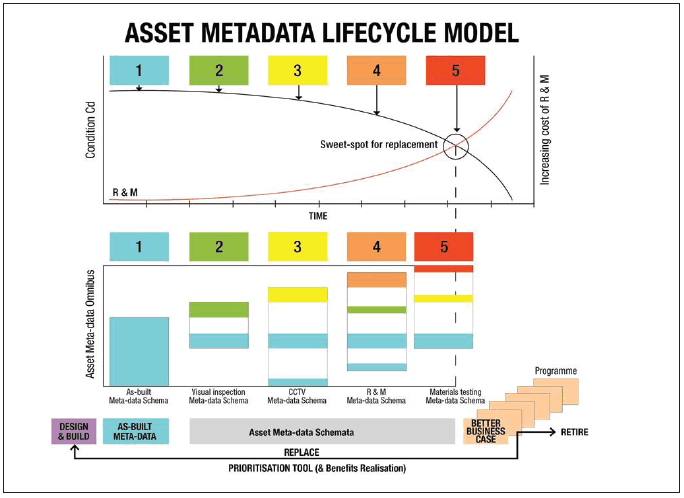
| Asset management is defined as activities carried out to determine the residual life of an asset (which establishes its condition). | Facilities management is defined as activities carried out to maintain the functionality of an asset (which establishes the cost of repairs and maintenance). |
| An asset's sweet-spot for replacement is defined as where the annualised cost of the capital renewal of an asset (including principal, interest, and depreciation) is less than the annual cost to repair and maintain the functionality of an asset. Note: There is a natural dependency relationship between these two disciplines that will influence the whole of life cost of an asset. A significant dependency on the timing of replacement is demand and criticality. | |
Deterioration and depreciation in the 31 local authorities
Knowledge about assets and their useful lives is needed for good financial planning
2.54
There are several drivers of asset funding needs, including maintenance, renewals, and building new assets. The depreciation expense reflects asset condition, asset value, and useful life. This affects future rates revenue and other funding requirements.
2.55
Long-term planning for the depreciation expense, which reflects the using up or wearing out of an asset over time, can be difficult. For instance, assessments of the useful life of an asset can change, and assets that property developers vest in local authorities add to a local authority's total assets, changing its depreciation expense.
2.56
Revaluations are important because they reflect changes in the useful life of assets, capital investment in assets critical to service delivery, and depreciation.
2.57
Local authorities typically carry out revaluations to determine an asset's fair value. In general, because of their specialised nature and the lack of a market for most infrastructure assets (such as roading and water supply assets), the best option for local authorities is to use depreciated replacement cost to value their infrastructure assets.
2.58
However, asset revaluations are only as good as the underlying asset data. Valuation cycles and the reliability of, or confidence in, the valuation data varies between local authorities and between asset classes. The reliability of, and confidence in, three waters asset data is more varied for some asset components.
2.59
All but one of the 31 local authorities revalue their infrastructure assets either annually or every three years. Most consider their valuation data to be reliable. This means that most of the data is based on sound records and has been adequately documented. However, the data might have minor shortcomings (such as some old or missing data).
Maintenance and renewals
It helps to know the maintenance you plan so you can recognise the unplanned
2.60
Maintenance requirements are likely to depend on the asset's criticality (consequence of failure), function, geography, environment, and operating procedures. As a general rule, planned maintenance is more cost-effective than unplanned maintenance. It is critical to subcategorise spending on maintenance into planned and unplanned maintenance.
2.61
For local authorities taking "just-in-time" approaches (see paragraphs 2.3-2.4), monitoring planned and unplanned maintenance can indicate where an asset is in its useful life and give an early warning that an asset might be about to fail.
Renewals expenditure to depreciation trend is downward
2.62
Renewals expenditure is the money an asset-intensive organisation uses to maintain its service capacity and capability. It means re-investing in the assets when components reach the end of their useful life and need to be replaced.
2.63
When assets need to be renewed, their costs could be covered by the amounts that have been raised through depreciation charges during the life of the asset. Local authorities calculate depreciation as an even allocation of the consumption of assets because depreciation is mostly a time-based calculation. Renewals expenditure, on the other hand, will not occur evenly during the life of the asset network.
2.64
When we compare renewals expenditure5 to depreciation, we assume that depreciation is a reasonable estimate of the capital expenditure needed to replace the existing asset base.
2.65
A result where renewals expenditure is equal to depreciation (100%) over time usually indicates that an asset (and therefore service) is sustainable. Figure 9 shows that local authorities' forecast renewals6 expenditure on physical assets is below depreciation7 from 2013 to 2022. It also shows a downward trend during that period.
Figure 9
Forecast annual renewals expenditure as a percentage of the depreciation expense, 2013 to 2022
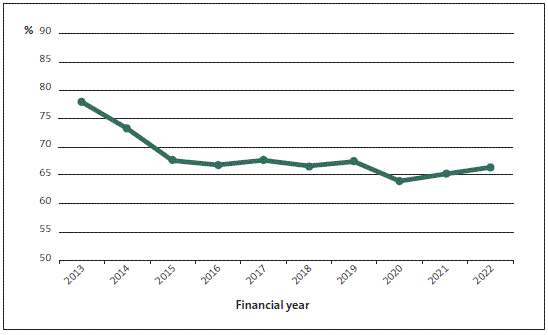
2.66
We have already noted that many local authorities were under financial pressure when preparing their 2012-22 long-term plans. They were looking for ways to manage the affordability of rates, including by delaying renewals work, so they expected assets to last longer than originally anticipated.
2.67
Such approaches should have two consequences: a deferral of renewals to a future period and a decrease in the depreciation expense, reflecting the expectation of a longer asset life. Local authorities might need to confirm that they have appropriately adjusted their forecasts to reflect the later timing of the renewal expense and the assets' increased useful lives.
Renewal rates are better for roading assets than for three waters assets
2.68
Local authorities are more likely to have higher reinvestment (based on renewals expenditure to depreciation) for their roading assets than their three waters assets. Figure 10 shows local authorities' 10-year average renewals expenditure to depreciation by asset class as forecast in their 2012-22 long-term plans.
Figure 10
Ten-year average renewals expenditure to depreciation, by asset class, as forecast in 2012-22 long-term plans
| Asset class | Average renewals expenditure to depreciation |
|---|---|
| Roading | 91% |
| Water supply | 72% |
| Wastewater | 58% |
| Storm water | 32% |
2.69
Some factors that might influence these different renewal rates include:
- Local authorities receive NZTA subsidies for capital expenditure on roads. Expenditure on three waters assets relies more on rates and other revenue.
- Our industry experts and practitioners estimated that roading assets were closer to the beginning of a renewal cycle than three waters assets.
Many smaller and provincial local authorities are focusing on infrastructure reinvestment more than community and social assets
2.70
Local authorities' spend a large proportion physical assets and capital expenditure on infrastructural assets. However, local authorities might also have significant community and social assets. These other assets typically include art galleries, libraries, museums, public toilets, stadiums, and social housing.
2.71
Figure 11 shows the total forecast capital expenditure for the five infrastructure activities (roading, the three waters, and flood control and protection), and for other activities, from local authorities' 2012-22 long-term plans.
2.72
The proportion of the total forecast capital expenditure on the five infrastructure activities is 65%. Just under half of that proportion (32%) is forecast to be spent on roading activities. The remaining 35% is forecast to be spent on assets for other activities.
Figure 11
Proportion of 10-year 2012-22 long-term plan accumulated total capital expenditure, by activity
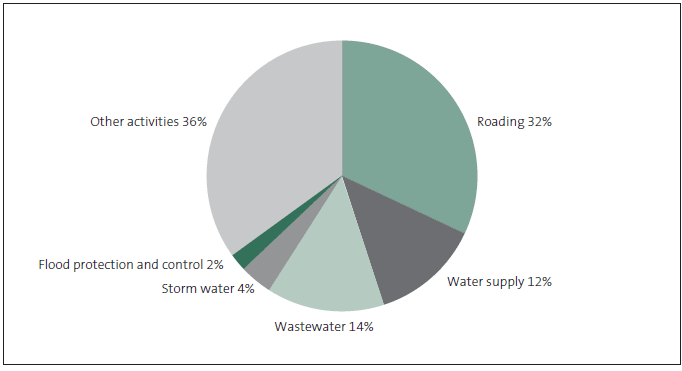
2.73
Large provincial and urban local authorities typically have more, and spend more on, other assets than smaller provincial local authorities. This group of local authorities and their forecast capital expenditure on other activities included Wellington City Council (43%), Selwyn District Council (49%), and Porirua City Council (49%).
2.74
Rural and/or small local authorities were more likely to focus their capital expenditure on maintaining the condition and service levels of roading and three waters infrastructure. This group of local authorities have stable, no, or declining growth. This group includes Southland District Council (5% of their forecast capital spending was on other activities), Clutha District Council (5%), and Central Hawke's Bay District Council (9%).
2.75
As shown in Figure 12, the ratio of renewals expenditure to depreciation for community and social other activities is forecast to decline during the 10 years to 2022. This suggests that local authorities are intending to reinvest comparatively less in those other assets, which typically have a lower useful life than roading and three waters assets. Industry experts and practitioners told us that, if there is a need to contain costs to lower rate increases, local authorities usually spend less on other assets.
Figure 12
Other activities – forecast renewals expenditure to depreciation
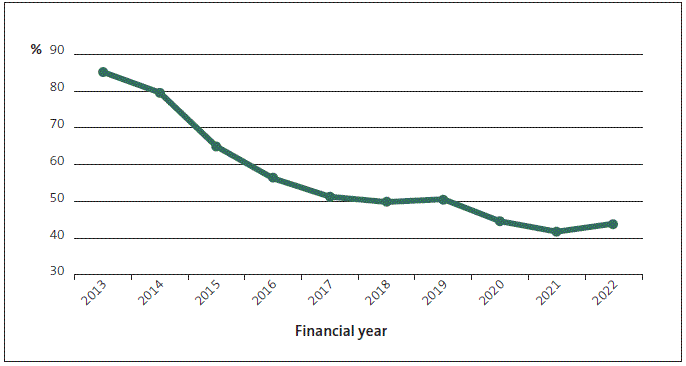
2.76
It is comparatively easier to take a "just-in-time" approach to renewing community and social assets than it is to renewing infrastructure assets. This is because assets such as public toilets, playgrounds, and stadiums are not part of a reticulated network. However, each local authority provides recreation and community assets for residents and ratepayers. Although critical failure of a community or social asset does not affect network performance, these assets can play an important part in the life of local communities. They need to be managed and planned for in consultation with those communities.
Local authorities need to prepare for funding infrastructure renewal cycles
2.77
In Figure 13, we show the accumulated renewals expenditure8 and depreciation forecast in the 2012-22 long-term plans for all local authorities. These forecasts indicate a "renewals/depreciation gap" – the difference between depreciation expenses and renewals expenditure – of between $6 billion and $7 billion by 2022.
Figure 13
Forecast accumulated renewals expenditure and depreciation
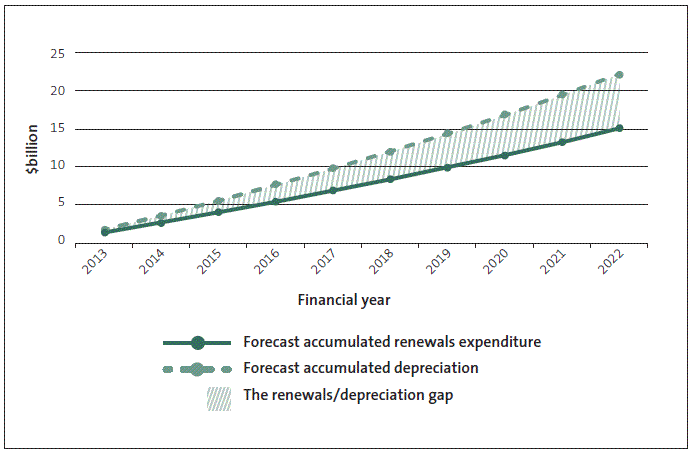
2.78
Because infrastructure assets typically have at least 50 years of useful life, we cannot draw firm conclusions about asset sustainability trends on the basis of 10-year forecast information. Several factors could contribute to the gap between renewals and depreciation. Depreciation could be overestimated (for instance, if local authorities do not review and adjust the useful lives of assets) or there could be changes in prices associated with asset renewal work over time.
2.79
However, the 2011 edition of the International Infrastructure Management Manual said that:
Along with many other countries, New Zealand is facing a looming infrastructure renewal peak which is not well-defined in quantum or timing. What is known is that a significant amount of infrastructure was developed during the 1940's-1970's and is reaching the end of its expected life. However, with much of this infrastructure underground, there is still much debate around what that life expectancy is. Funding the renewal of this infrastructure together with continuing to invest to meet growth requirements will be an ongoing challenge.9
2.80
Local authorities could end up relying on rates to fund an infrastructure gap. Better information is needed so any gap can be forecast and managed with more confidence.
2.81
If depreciation is funded, it could be that funds not directed to renewals in the forecast period are being raised in anticipation of longer-term asset renewal requirements. Industry experts and practitioners told us that:
- many roading assets could be approaching second or third renewal cycles;
- a renewal cycle for bridges is likely to begin around 2025; and
- significant renewals of three waters assets are likely between 2040 and 2060.
2.82
If depreciation funding is being deferred or held back for spending in future years, we would expect to see an associated increase in forecast cash, reserves, or investments, and/or a forecast decrease in borrowing.
2.83
However, as shown in Figure 14, forecast increases in assets, excluding fixed assets, are trending well below the growing renewals/depreciation gap and total debt is forecast to continue increasing.10
Figure 14
The renewals/depreciation gap compared to changes in other assets and debt
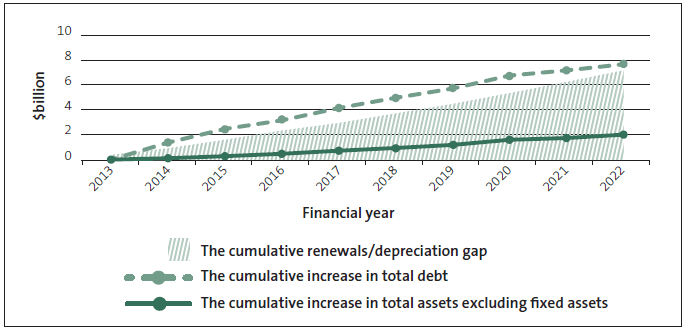
2.84
These forecasts suggest that local authorities could be expecting to use depreciation and/or debt funding on new assets or on other activities within the organisation. If they are, the options for funding the growing renewals/depreciation gap in the future could be limited to rates and/or other income.
2.85
The requirement for local authorities to prepare 30-year infrastructure strategies, if prepared with integrity, will help to explain local authorities' forecast capital reinvestment intentions. This, in turn, will help deliver a more appropriate set of funding options and a more robust long-term financial strategy. The 30-year strategies should start to identify and provide evidence for decision-makers about likely service delivery implications and funding needs for the early 2040s.
2: Matters arising from the 2012-22 local authority long-term plans (2012), paragraphs 2.22-2.46.
3: Dr Theuns Henning, Senior Lecturer, Civil and Environmental Engineering, University of Auckland, correspondence to the Office of the Auditor-General, 20 October 2014.
4: Watercare is not included because its financial statements do not include forecast data.
5: Clause 3 of Schedule 10 to the Local Government Act 2002 requires local authorities to allocate capital expenditure to one of three primary purposes. Capital expenditure budgeted for two or all of these purposes may be treated as if it were made solely for the primary purpose of the expenditure. Therefore, it is possible that the renewal amounts include aspects of the other two expenditure categories.
6: Renewals are "works to replace existing assets or facilities with assets or facilities of equivalent capacity or performance capability". Depreciation amounts also include amortisation.
7: We took the data for depreciation from local authorities' annual financial statements. The data includes amortisation and depreciation on any new capital expenditure during the year. Adjusting depreciation for these factors does not materially affect the graph or our conclusions.
8: We were unable to obtain the forecast maintenance figures from the 2012-22 long-term plans because local authorities are not required to disclose that information.
9: Page 5/17.
10: Christchurch City Council is not included in this data because it was not required to prepare a long-term plan in 2012. Auckland Council's group debt is significant – for each year, it represents more than half of the sector's total debt.

